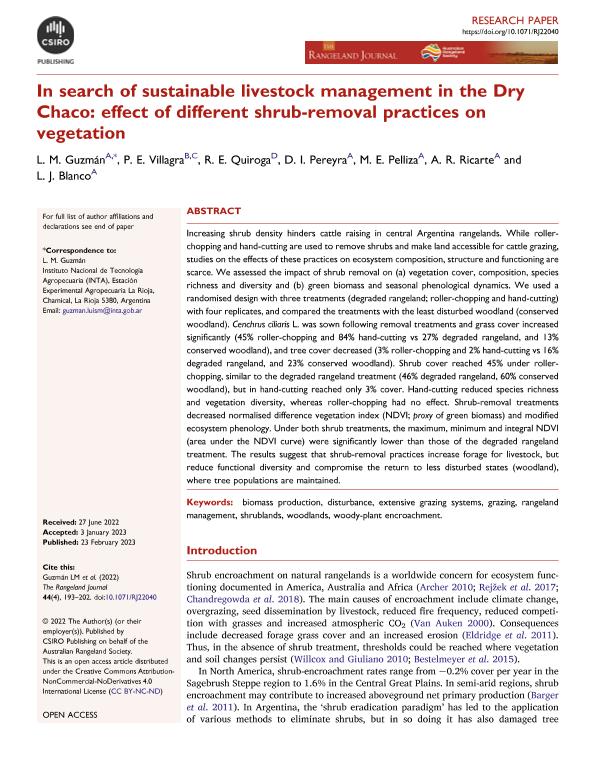Mostrar el registro sencillo del ítem
dc.contributor.author
Guzmán, L. M.
dc.contributor.author
Villagra, Pablo Eugenio

dc.contributor.author
Quiroga, Raul Emiliano

dc.contributor.author
Pereyra, D. I.
dc.contributor.author
Pelliza, M. E.
dc.contributor.author
Ricarte, A. R.
dc.contributor.author
Blanco, L. J.
dc.date.available
2024-04-15T18:09:41Z
dc.date.issued
2023-02
dc.identifier.citation
Guzmán, L. M.; Villagra, Pablo Eugenio; Quiroga, Raul Emiliano; Pereyra, D. I.; Pelliza, M. E.; et al.; In search of sustainable livestock management in the Dry Chaco: effect of different shrub-removal practices on vegetation; Australian Rangeland Society; Rangeland Journal; 44; 4; 2-2023; 193-202
dc.identifier.issn
1036-9872
dc.identifier.uri
http://hdl.handle.net/11336/233066
dc.description.abstract
Increasing shrub density hinders cattle raising in central Argentina rangelands. While roller-chopping and hand-cutting are used to remove shrubs and make land accessible for cattle grazing, studies on the effects of these practices on ecosystem composition, structure and functioning are scarce. We assessed the impact of shrub removal on (a) vegetation cover, composition, species richness and diversity and (b) green biomass and seasonal phenological dynamics. We used a randomised design with three treatments (degraded rangeland; roller-chopping and hand-cutting) with four replicates, and compared the treatments with the least disturbed woodland (conserved woodland). Cenchrus ciliaris L. was sown following removal treatments and grass cover increased significantly (45% roller-chopping and 84% hand-cutting vs 27% degraded rangeland, and 13% conserved woodland), and tree cover decreased (3% roller-chopping and 2% hand-cutting vs 16% degraded rangeland, and 23% conserved woodland). Shrub cover reached 45% under roller-chopping, similar to the degraded rangeland treatment (46% degraded rangeland, 60% conserved woodland), but in hand-cutting reached only 3% cover. Hand-cutting reduced species richness and vegetation diversity, whereas roller-chopping had no effect. Shrub-removal treatments decreased normalised difference vegetation index (NDVI; proxy of green biomass) and modified ecosystem phenology. Under both shrub treatments, the maximum, minimum and integral NDVI (area under the NDVI curve) were significantly lower than those of the degraded rangeland treatment. The results suggest that shrub-removal practices increase forage for livestock, but reduce functional diversity and compromise the return to less disturbed states (woodland), where tree populations are maintained.
dc.format
application/pdf
dc.language.iso
eng
dc.publisher
Australian Rangeland Society

dc.rights
info:eu-repo/semantics/openAccess
dc.rights.uri
https://creativecommons.org/licenses/by-nc-nd/2.5/ar/
dc.subject
BIOMASS PRODUCTION
dc.subject
DISTURBANCE
dc.subject
GRAZING
dc.subject
RANGELANDS
dc.subject.classification
Ganadería

dc.subject.classification
Producción Animal y Lechería

dc.subject.classification
CIENCIAS AGRÍCOLAS

dc.title
In search of sustainable livestock management in the Dry Chaco: effect of different shrub-removal practices on vegetation
dc.type
info:eu-repo/semantics/article
dc.type
info:ar-repo/semantics/artículo
dc.type
info:eu-repo/semantics/publishedVersion
dc.date.updated
2024-03-13T15:15:12Z
dc.journal.volume
44
dc.journal.number
4
dc.journal.pagination
193-202
dc.journal.pais
Australia

dc.description.fil
Fil: Guzmán, L. M.. Instituto Nacional de Tecnología Agropecuaria. Centro Regional Catamarca-La Rioja. Estación Experimental Agropecuaria La Rioja; Argentina
dc.description.fil
Fil: Villagra, Pablo Eugenio. Consejo Nacional de Investigaciones Científicas y Técnicas. Centro Científico Tecnológico Conicet - Mendoza. Instituto Argentino de Nivología, Glaciología y Ciencias Ambientales. Provincia de Mendoza. Instituto Argentino de Nivología, Glaciología y Ciencias Ambientales. Universidad Nacional de Cuyo. Instituto Argentino de Nivología, Glaciología y Ciencias Ambientales; Argentina. Universidad Nacional de Cuyo. Facultad de Ciencias Agrarias; Argentina
dc.description.fil
Fil: Quiroga, Raul Emiliano. Instituto Nacional de Tecnología Agropecuaria. Centro Regional Catamarca-La Rioja. Estación Experimental Agropecuaria Catamarca; Argentina
dc.description.fil
Fil: Pereyra, D. I.. Instituto Nacional de Tecnología Agropecuaria. Centro Regional Catamarca-La Rioja. Estación Experimental Agropecuaria La Rioja; Argentina
dc.description.fil
Fil: Pelliza, M. E.. Instituto Nacional de Tecnología Agropecuaria. Centro Regional Catamarca-La Rioja. Estación Experimental Agropecuaria La Rioja; Argentina
dc.description.fil
Fil: Ricarte, A. R.. Instituto Nacional de Tecnología Agropecuaria. Centro Regional Catamarca-La Rioja. Estación Experimental Agropecuaria La Rioja; Argentina
dc.description.fil
Fil: Blanco, L. J.. Instituto Nacional de Tecnología Agropecuaria. Centro Regional Catamarca-La Rioja. Estación Experimental Agropecuaria La Rioja; Argentina
dc.journal.title
Rangeland Journal

dc.relation.alternativeid
info:eu-repo/semantics/altIdentifier/url/https://www.publish.csiro.au/RJ/RJ22040
dc.relation.alternativeid
info:eu-repo/semantics/altIdentifier/doi/https://doi.org/10.1071/RJ22040
Archivos asociados
